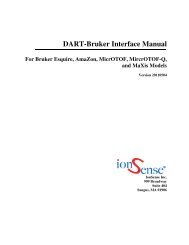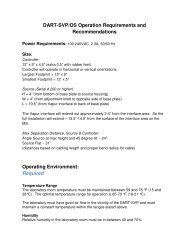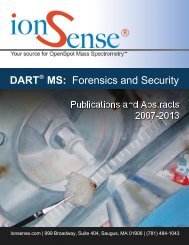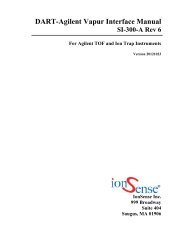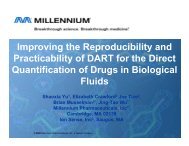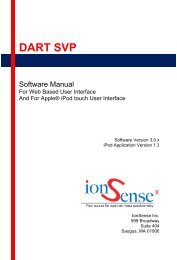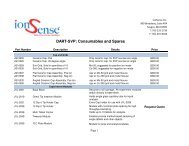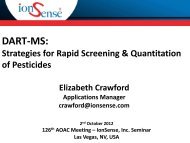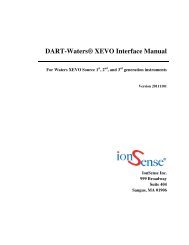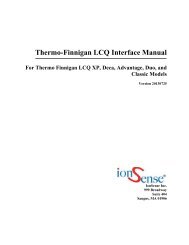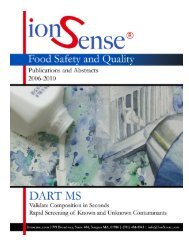Rapid Screening of Edible Oils - IonSense
Rapid Screening of Edible Oils - IonSense
Rapid Screening of Edible Oils - IonSense
You also want an ePaper? Increase the reach of your titles
YUMPU automatically turns print PDFs into web optimized ePapers that Google loves.
<strong>Rapid</strong> Characterization <strong>of</strong> <strong>Edible</strong> <strong>Oils</strong> for<br />
Purity and Composition using Open Air<br />
Direct Analysis in Real Time (DART) Mass<br />
Spectrometry for Quality Assessment<br />
B.D. Musselman, E. Crawford, J. Krechmer<br />
<strong>IonSense</strong>, Inc., Saugus, MA, USA
Abstract<br />
<strong>Rapid</strong> analysis <strong>of</strong> edible oils for composition and<br />
presence potential adulterants is facilitated by using<br />
direct analysis in real time (DART) ionization technique<br />
coupled with mass spectrometry. Characterization <strong>of</strong><br />
the major components <strong>of</strong> oil including triglyceride,<br />
diglyceride and fatty acids without sample preparation<br />
is completed in a few seconds per sample. Recently,<br />
determination <strong>of</strong> the distribution <strong>of</strong> these components in<br />
different olive oils has been utilized to differentiate the<br />
grade <strong>of</strong> these oils. We have investigated the use <strong>of</strong> this<br />
technology, operated in a high throughput configuration<br />
to permit detection <strong>of</strong> common adulterants in edible oil<br />
including; less expensive oils used for economic<br />
adulteration, random contaminants, and non-oil based<br />
products that might be mixed with oils in production<br />
errors will be described.
The Multi-DIP-it® holder moves 12 samples across the<br />
ionization stream in under 4 minutes. It allows for<br />
extremely consistent and reproducible sampling.
Mass chromatograms and spectrum obtained from Wild<br />
Oats-brand Extra Virgin Olive Oil.<br />
The positive-ion spectrum shows the tri- and di-glycerides with<br />
corresponding isotopes. The various extracted-ion chromatograms show<br />
the reproducibility <strong>of</strong> the method over multiple samples.<br />
Diglycerides<br />
Triglycerides
Desorption<br />
Sampler<br />
Glass inserts (SPOT-its)<br />
with small reserviors on top<br />
are inserted into a<br />
96 well-microtiter plate with<br />
the closed end up<br />
Sample Spotting<br />
10ul <strong>of</strong> each oils is pipetted<br />
onto the tops <strong>of</strong> the each<br />
insert<br />
Sample Array<br />
Sequential positioning <strong>of</strong><br />
samples allow for rapid MS<br />
analysis when the plate is<br />
moved to the DART-MS
Sample plate is placed on a X-Y stage with positioning under<br />
digital control. Desorption ionization in open air occurs as each<br />
individual sample enters the region under the DART source gas<br />
exit and the VAPUR tube leading to the Ion Trap-MS.<br />
Source<br />
Controller<br />
DART<br />
Source<br />
MS<br />
Desorption<br />
Region
In a recent publication, Vaclavik et al. demonstrated the reliable detection <strong>of</strong><br />
counterfeit olive oils by analyzing samples on a high-resolution DART-<br />
AccuTOF instrument (JEOL) and then using linear<br />
discriminant analysis to identify adulterated samples.<br />
EVOO<br />
Hazelnut Oil<br />
Olive Pomace Oil<br />
Olive Oil<br />
Pictured above are the spectra <strong>of</strong> four oils analyzed on an AccuTOF-DART showing<br />
the high-resolution triacylglycerols (TAGs) and diacylglycerols produced during the<br />
ionization process.
Positive Ion Spectra <strong>of</strong> Various <strong>Oils</strong><br />
Distinguishing positive-ion spectra from various grades <strong>of</strong> olive oil is<br />
difficult unit however other oils yield quiet different mass spectra.<br />
EVOO<br />
100% Pure OO<br />
Mild OO<br />
Vegetable Oil<br />
Toasted Sesame Oil
Principle Component Analysis<br />
Differentiating the addition <strong>of</strong> even small percentages <strong>of</strong> mild olive oil<br />
to the olive oil can be detected using PCA statistical analysis
Negative-ion spectra for five different edible oils<br />
Negative-ion spectra are easily acquired<br />
Major differences in ions and their abundance oils can be used to<br />
easily differentiate oil quality and type.
Principle Component Analysis<br />
PCA <strong>of</strong> the mass spectra from the different oils provides reasonable<br />
differentiation by type
Detection <strong>of</strong> Mixed <strong>Oils</strong><br />
50 ml quantity <strong>of</strong> olive oil was spiked with 0.5ml <strong>of</strong> toasted<br />
sesame oil and then diluted with olive oil times. The<br />
resulting solutions were analyzed using negative-ion DART.<br />
The spectra below show that even at low concentrations<br />
the 395 and 435 m/z ions which are more abundant in<br />
Sesame oil are detected with the Extra Virgin Olive Oil ions.<br />
Pure EVOO<br />
EVOO w/ 1% Sesame Oil<br />
EVOO w/ .1% Sesame Oil<br />
EVOO w/ .01% Sesame Oil<br />
EVOO w/ .001% Sesame Oil
Pictured below are extracted-ion chromatographs for the circled ions in the<br />
spectra on the proceeding page. The presence <strong>of</strong> sesame oil is readily<br />
detected at several different concentrations in Extra Virgin Olive Oil (EVOO)<br />
by tracking the abundances <strong>of</strong> two characteristic negative ions. This<br />
demonstrates the promise <strong>of</strong> a rapid screening technique for the detection<br />
<strong>of</strong> edible oil adulterants. The lack <strong>of</strong> a calibration curve is most likely due to<br />
limitations <strong>of</strong> the ion trap MS.<br />
1% Sesame 0.01% Sesame<br />
0.1% Sesame 0.001% Sesame<br />
EVOO<br />
m/z 435<br />
m/z 395
This slide shows the negative-ion spectrum and extracted ion<br />
chromatogram <strong>of</strong> twelve edible oils samples, <strong>of</strong> which 10 are Extra<br />
Virgin Olive Oil and 2 are Olive Oil. The relative abundance <strong>of</strong> m/z<br />
563 and 257. In the extracted ion chromatogram the two olive oil<br />
peaks are clearly identified.<br />
m/z 563<br />
m/z 282<br />
m/z 257
Conclusions<br />
• <strong>Rapid</strong> production <strong>of</strong> mass spectra containing intact<br />
protonated TAG’s is feasible with DART<br />
• Detection <strong>of</strong> mixtures <strong>of</strong> different oils in seconds<br />
facilitates more active screening <strong>of</strong> raw materials for<br />
possible adulteration<br />
• PCA provides a tool for automated inspection <strong>of</strong> oil<br />
quality and authenticity<br />
• New Open Air Technology capable <strong>of</strong> reducing<br />
thermal degredation during ionization is in<br />
development
References<br />
• L. Vaclavik et al. / Analytica Chimica Acta 645<br />
(2009) 56–63<br />
• Cody, R.B.; Laramée, J.A.; Durst, H.D. Versatile<br />
New Ion Source for the Analysis <strong>of</strong> Materials in<br />
Open Air under Ambient Conditions. Anal.<br />
Chem., 2005, 77(8), 2297-2302.




